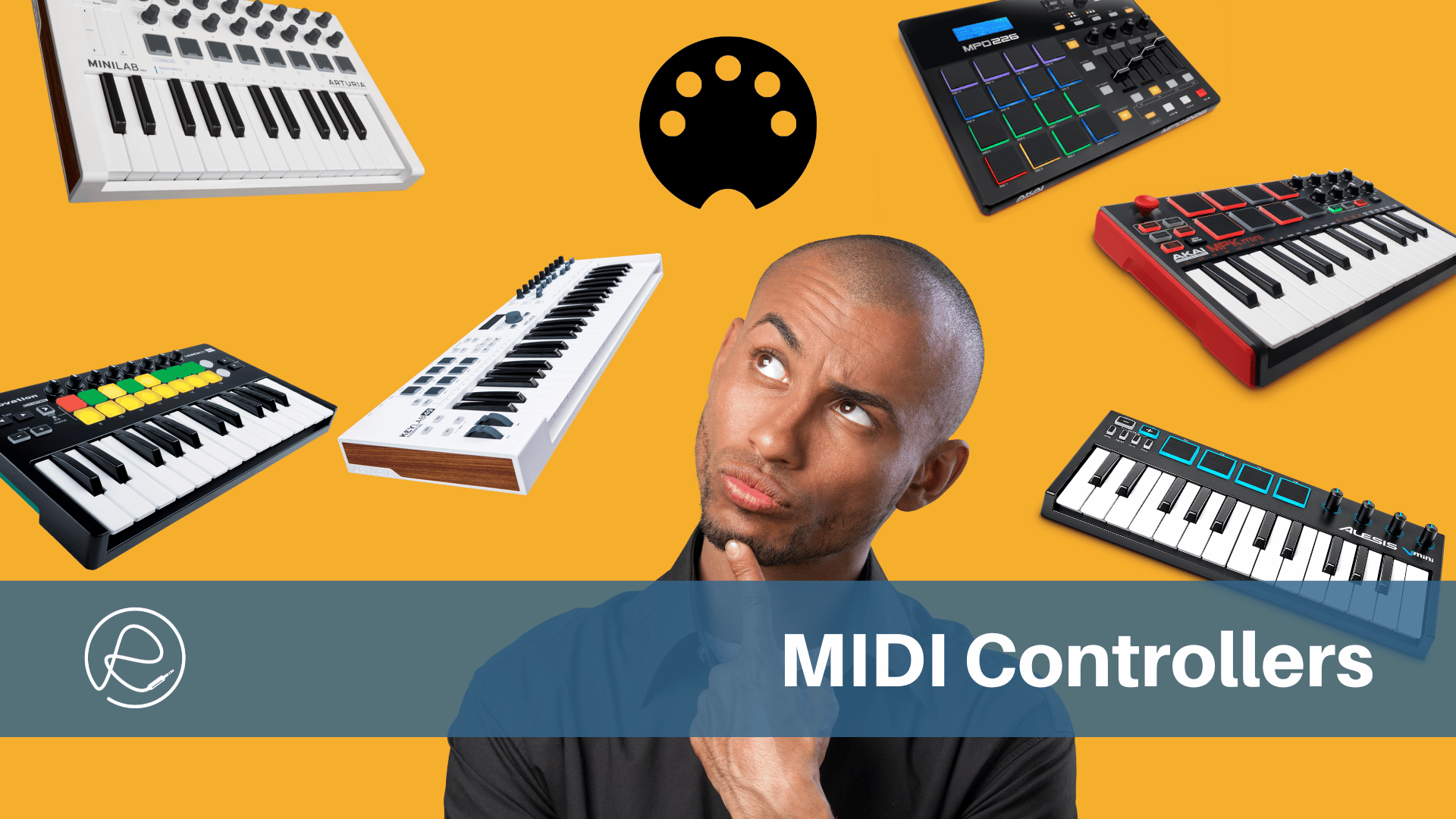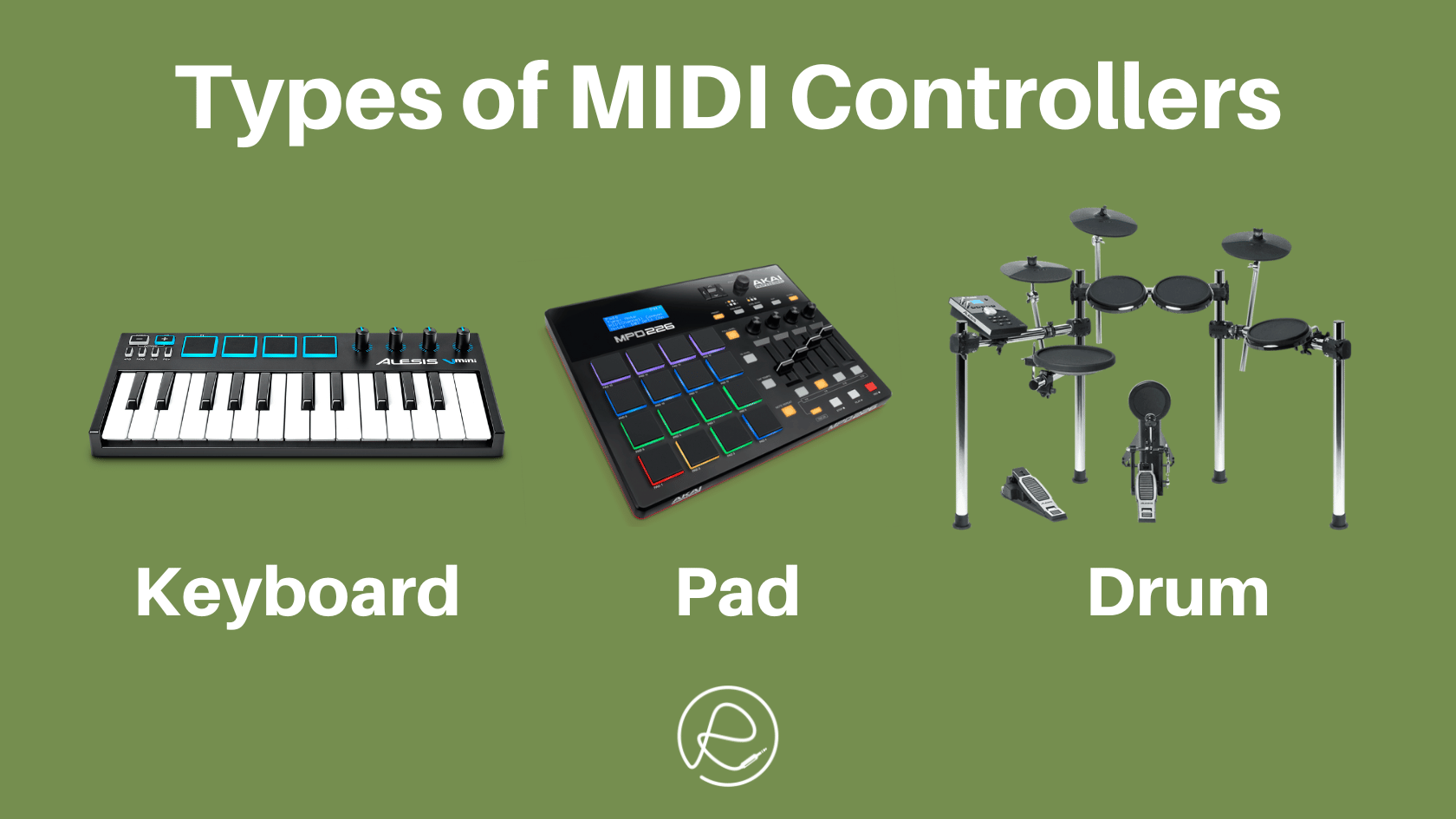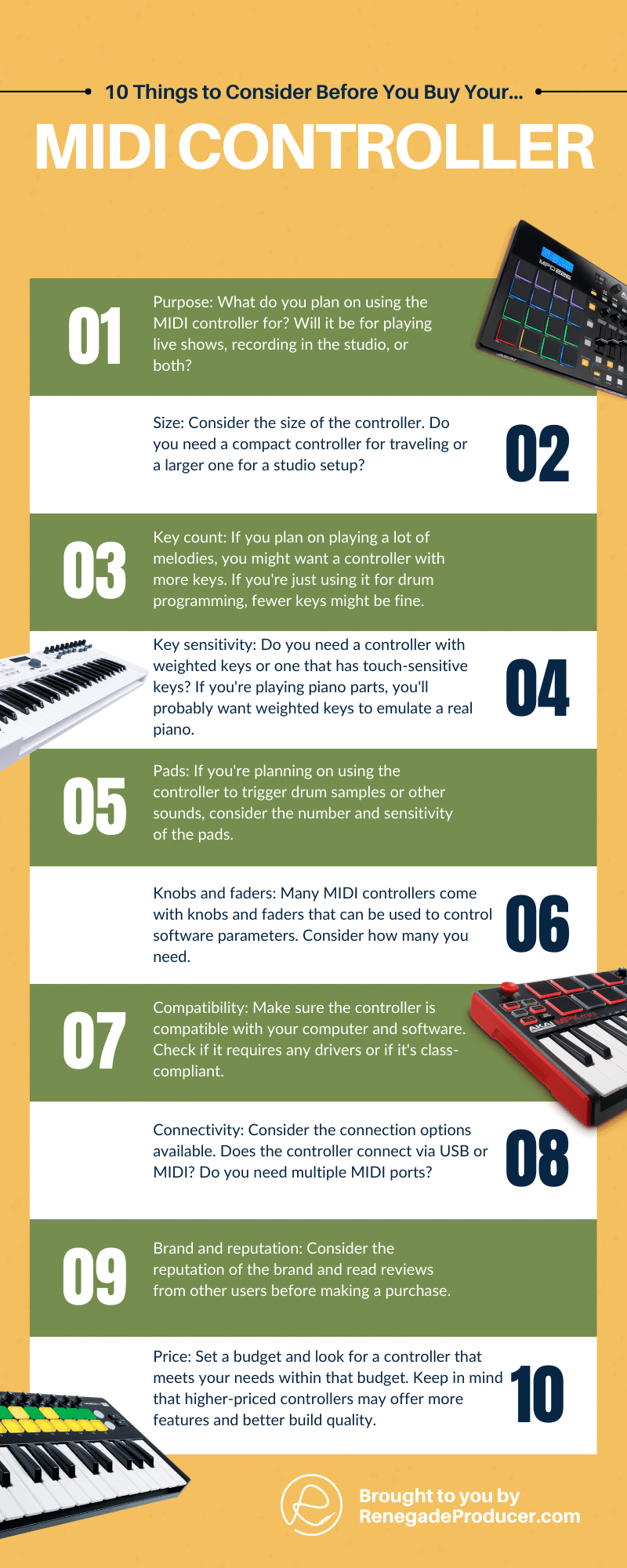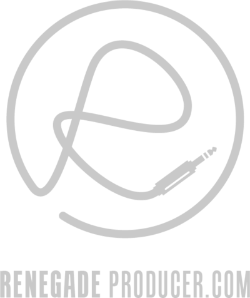25-step music production process checklist and video workshop >>>
Choosing a MIDI Controller: The Ultimate Guide for Beginner Home Studio Music Producers
If you're a music producer setting up your home studio, you'll need a MIDI controller. But what is it, and how do you choose the right one for your needs?
This comprehensive guide will walk you through everything you need to know to make an informed decision.

Understanding MIDI Controllers
MIDI controllers are devices that allow you to control digital audio workstation (DAW) software, such as Ableton Live or Logic Pro X.
MIDI stands for “Musical Instrument Digital Interface” which is the language used by digital music equipment to communicate with each other.
In other words, MIDI is a protocol that enables your MIDI controller to communicate with your computer.
The main thing to keep in mind is that a MIDI controller doesn't produce sound. A MIDI controller generates MIDI note information that is read by your software or hardware that will gen
Different Types of MIDI Controllers Used By Music Producers in the Home Studio

There are many types of MIDI controllers available, each with its own unique set of features.
Keyboard controllers are the most popular type and are ideal for playing and recording melodies and chords.
Pad controllers are great for creating beats and triggering samples, while drum controllers are perfect for programming drum tracks.
Other controllers may only have faders and knobs similar to mixing desks.
Choosing the Right MIDI Controller
When choosing a MIDI controller, consider the size, the number of keys, the pad quality, compatibility, and additional features.
The size of the MIDI controller should fit the available space in your studio. Keyboard controllers with a full-sized keyboard are ideal for keyboard players, while a smaller pad controller is better for drum programming or beat-making.
Pay attention to the pad quality if you’re using your MIDI controller for drum programming or beat-making.
Ensure that the MIDI controller you choose is compatible with your DAW software, and look out for any additional features such as faders, knobs, or buttons that you may need.
Some controllers, notably those created by software developers like Native Instruments and Arturia, are excellent for use with their related software. Other controllers like Ableton's Push integrates seamlessly with Ableton Live.
So, your choice of controller will in some way be influenced by your choice in software and plugins. Always be sure to check if the controller you want will work well with your DAW.

Setting Up Your MIDI Controller in Your DAW
Each DAW has a slightly different way of setting up a controller for use. Below I provide the basic process. Check your DAW help or manual to get instructions specific to your DAW.
- Connect your MIDI controller to your computer. In most cases this will be done via a USB cable.
- Next, launch your DAW and start a new project.
- Go to the preferences or options menu and select MIDI or MIDI devices.
- Select your MIDI device from the available options.
- Test the connection by loading up a virtual instrument and playing some notes on your controller or hitting pads.
- You can also assign different knobs and faders to different parameters and functions in your DAW or virtual instruments. This is usually done by activating “MIDI Learn” on the parameter or function and then moving the knob or fader you want to use to control it.
By going through these steps you should be ready to use your controller with your chosen DAW. Again, consult your DAW manual should you have any issue setting up your controller.
Different Ways to Use a MIDI Controller in Your Home Studio
Once you have your MIDI controller, you can use it to create expressive performances, control your DAW, customize your MIDI controller to suit your workflow, and learn keyboard shortcuts for your DAW.
Use Your MIDI Controller to Create Expressive Performances
Your MIDI controller allows you to create expressive performances that are difficult to achieve using a computer keyboard or mouse.
Velocity, aftertouch, pitch-bend and modulation controls, along with assigned faders and knobs can all be used during performance to add expression and nuance to your writing and recording.
Experiment with different playing styles, mappings and techniques to create unique and interesting sounds.
Use Your MIDI Controller to Control Your DAW
Your MIDI controller can also be used to control your DAW. This can be especially useful if you prefer a hands-on approach to music production.
Once mapped, you can use the knobs, faders, and buttons on your controller to adjust levels, add effects, adjust filters and control almost any other parameters in your DAW or on your virtual instruments and effects plugins.
Customize Your MIDI Controller to Suit Your Workflow
Most MIDI controllers come with default settings that may not be optimized for your workflow.
Take some time to customize your controller to suit your needs. This can include mapping controls to specific functions in your DAW, setting up presets for different instruments, and creating macros to speed up your workflow.
You may also be able to find pre-made templates for your controller that will make your setup process a little bit easier.
Learn Keyboard Shortcuts for Your DAW
In addition to using your MIDI controller, you should also learn keyboard shortcuts for your DAW. This can help you work more efficiently and reduce the need to switch between your controller and computer keyboard.
Conclusion: Your First MIDI Controller
In summary, a MIDI controller is an essential tool for any music producer setting up a home studio.
There are many types of MIDI controllers available, so it's important to choose the one that fits your needs.
Once you have your MIDI controller, you can use it to create expressive performances, control your DAW, customize it to suit your workflow, and learn keyboard shortcuts for your DAW.
With these tips and tricks, you'll be able to make the most of your new MIDI controller and take your music production to the next level.
4 Top MIDI Controller Recommendations for Beginner Music Producers:
- Akai MPK Mini MK3 - This compact keyboard features 25 velocity-sensitive keys, eight backlit drum pads, and eight assignable knobs, making it a great choice for beginners who want a versatile and portable controller.
- M-Audio Keystation 49 MK3 - With 49 full-size velocity-sensitive keys, pitch bend and modulation wheels, and transport controls, this keyboard is perfect for those who want a more traditional piano-style playing experience.
- Novation Launchkey Mini MK3 - This keyboard offers 25 mini keys, eight velocity-sensitive pads, and 16 rotary knobs, making it a great option for those who want to create beats and melodies on the go.
- Arturia MiniLab MKII - This keyboard has 25 velocity-sensitive keys, 16 rotary knobs, and eight backlit pads, making it a great option for those who want to control multiple parameters simultaneously.
All of these keyboards are great options for beginners, but it's important to consider your individual needs and preferences before making a purchase.

Common Midi Controller Questions:
Below you'll find some common questions about MIDI controllers answered.
Question: What does a MIDI controller do?
Answer: A MIDI controller is a hardware device that sends MIDI messages to either software or other hardware devices. The controller can be a keyboard, drum pad, fader or other type of interface. The most common use for music producers is to use a MIDI controller to control software like DAWs and DAW plugin parameters and fubnctions.
Question: Is a MIDI controller good for beginners?
Answer: Yes, a MIDI controller can be a great tool for beginners, as it allows them to easily start playing and experimenting with digital instruments and effects without needing a full physical setup.
Beginner producers will definitely benefit from having a MIDI controller in their home studio setup. While it’s not absolutely essential to make music it makes it so much easier. You can, for instance, use your mouse and keyboard to program your music in a DAW but the process will be much more tedious and definitely much slower.
Question: What is the difference between a MIDI keyboard and a MIDI controller?
Answer: A MIDI keyboard is a specific type of MIDI controller that is designed to look and feel like a traditional piano keyboard, whereas a MIDI controller can take on a variety of forms and functionalities beyond keyboard input.
In simple terms, all MIDI keyboards are MIDI controllers, but not all MIDI controllers are MIDI keyboards. A MIDI keyboard is simply a MIDI controller that has keys like a piano.
Question: Do I need a MIDI controller or keyboard?
Answer: No, you don’t. You can make music without it. If you plan to use virtual instruments in your DAW then a MIDI controller, especially a MIDI keyboard is a good thing to have.
Question: Can a normal keyboard be used as a MIDI controller?
Answer: Yes, it can, with the right setup. That said, it will be limited as it won’t have the functionality that faders and knobs and velocity sensitive keys has on a MIDI keyboard.
Question: What are the most important features to consider when choosing a MIDI controller for a home studio setup?
Answer: Any of the following considerations may be important to you:
- How many keys it has.
- The sensitivity and feel of the keys and pads.
- Build quality.
- Does it have pads, faders, rotary knobs?
- Brand reputation and support.
- Inputs and outputs.
Question: What are the best brands of MIDI controllers for home studio music production, and why?
Answer: The top manufacturer brands that come to mind with MIDI controllers are:
Akai
Novation
M-Audio
Arturia
Question: How can a MIDI controller be used to improve the creative process of music production?
Answer: A MIDI controller allows you to add expression and a human-like feel to your music production. Apart from this it will also speed up your music production workflow.
Question: What is the ideal size and type of a MIDI controller for a home studio setup?
Answer: The best size and type will depend on various personal factors.
- Are you a really good pianist or keyboardist? You may want a full 88-key controller.
- Do you plan to mostly use it for finger drumming and to trigger samples? Get a drum pad controller.
- Do you simply want to control mixing parameters in your DAW? Get a controller that has faders and knobs only.
Question: What is the impact of aftertouch and velocity sensitivity on the performance of a MIDI controller?
Answer: Aftertouch gives you the ability to control a note or sound after it has been played.
Velocity sensitivity relates to how the volume and intensity information increments gets transmitted based on how hard you play the key or pad.

MIDI Controller Terminology that’s helpful to know as a music producer:
- MIDI: Musical Instrument Digital Interface, a protocol used for communicating musical performance data between electronic devices.
- MIDI Controller: a device that sends MIDI messages to control digital audio devices or trigger sounds.
- MIDI Keyboard: a type of MIDI controller designed to look and feel like a traditional piano keyboard.
- MIDI Drum Pad: a type of MIDI controller designed to trigger drum and percussion sounds.
- MIDI Fader: a type of MIDI controller designed to adjust levels and parameters of audio and MIDI data.
- MIDI Knob: a type of MIDI controller designed to adjust parameters of audio and MIDI data.
- MIDI Button: a type of MIDI controller designed to trigger specific MIDI messages or actions.
- Aftertouch: a MIDI message that is sent when pressure is applied to a key or pad after it has been played, allowing for additional expression and control.
- Velocity: a MIDI message that is sent to indicate the speed and force with which a key or pad is played, allowing for dynamic control of volume and tone.
- Pitch Bend: a MIDI message that is sent to change the pitch of a note, usually via a pitch bend wheel or joystick on the MIDI controller.
- Modulation: a MIDI message that is sent to modulate various parameters of a sound, such as vibrato or filter cutoff.
- Channel Pressure: a MIDI message that is sent to apply pressure to all keys or pads on a specific MIDI channel.
- Program Change: a MIDI message that is sent to change the program or preset on a connected MIDI device.
- Control Change: a MIDI message that is sent to adjust various parameters on a connected MIDI device, such as volume or pan.
- Polyphonic Aftertouch: a MIDI message that is sent when pressure is applied to multiple keys or pads simultaneously, allowing for even greater expression and control.
- Octave Switch: a feature on MIDI keyboards that allows the user to transpose the pitch of the keyboard up or down by one or more octaves.
- Sustain Pedal: a pedal that is used to sustain notes on a MIDI keyboard or other MIDI controller.
- Expression Pedal: a pedal that is used to control various parameters, such as volume or modulation, on a connected MIDI device.
- Breath Controller: a type of MIDI controller that is used to control various parameters, such as volume or modulation, by blowing into a breath sensor.
- Sequencer: a device or software program that is used to record and playback MIDI data.
- Digital Audio Workstation (DAW): a software program that is used for recording, editing, and mixing digital audio and MIDI data.


Learn to understand equalisers and frequencies to supercharge your mixing skills and get results, fast...

New producer? Learn everything you need to produce your first professional track right now...

Would you like to discover the simplest and easiest way to learn music theory as a music producer?
Share this post. Spread the knowledge so other producers can benefit too:
- Renegade Producer
- Home Studio
- MIDI Controller
ⓘ Some pages contain affiliate links so I might earn a commission when you buy through my links. Thanks for your support! Learn more

